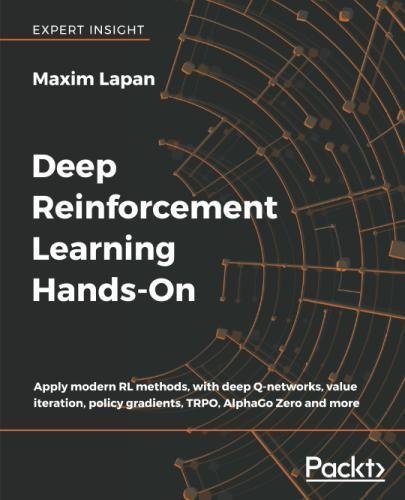What do you think?
Rate this book


This practical guide will teach you how deep learning (DL) can be used to solve complex real-world problems.
Key Features Explore deep reinforcement learning (RL), from the first principles to the latest algorithms Evaluate high-profile RL methods, including value iteration, deep Q-networks, policy gradients, TRPO, PPO, DDPG, D4PG, evolution strategies and genetic algorithms Keep up with the very latest industry developments, including AI-driven chatbots Book DescriptionRecent developments in reinforcement learning (RL), combined with deep learning (DL), have seen unprecedented progress made towards training agents to solve complex problems in a human-like way. Google's use of algorithms to play and defeat the well-known Atari arcade games has propelled the field to prominence, and researchers are generating new ideas at a rapid pace.
Deep Reinforcement Learning Hands-On is a comprehensive guide to the very latest DL tools and their limitations. You will evaluate methods including Cross-entropy and policy gradients, before applying them to real-world environments. Take on both the Atari set of virtual games and family favorites such as Connect4. The book provides an introduction to the basics of RL, giving you the know-how to code intelligent learning agents to take on a formidable array of practical tasks. Discover how to implement Q-learning on 'grid world' environments, teach your agent to buy and trade stocks, and find out how natural language models are driving the boom in chatbots.
What you will learn Understand the DL context of RL and implement complex DL models Learn the foundation of RL: Markov decision processes Evaluate RL methods including Cross-entropy, DQN, Actor-Critic, TRPO, PPO, DDPG, D4PG and others Discover how to deal with discrete and continuous action spaces in various environments Defeat Atari arcade games using the value iteration method Create your own OpenAI Gym environment to train a stock trading agent Teach your agent to play Connect4 using AlphaGo Zero Explore the very latest deep RL research on topics including AI-driven chatbots Who This Book Is ForSome fluency in Python is assumed. Basic deep learning (DL) approaches should be familiar to readers and some practical experience in DL will be helpful. This book is an introduction to deep reinforcement learning (RL) and requires no background in RL.
Table of Contents What is Reinforcement Learning? OpenAI Gym Deep Learning with PyTorch The Cross-Entropy Method Tabular Learning and the Bellman Equation Deep Q-Networks DQN Extensions Stocks Trading Using RL Policy Gradients – An Alternative The Actor-Critic Method Asynchronous Advantage Actor-Critic Chatbots Training with RL Web Navigation Continuous Action Space Trust Regions – TRPO, PPO, and ACKTR Black-Box Optimization in RL Beyond Model-Free – Imagination AlphaGo Zero546 pages, Paperback
Published June 21, 2018